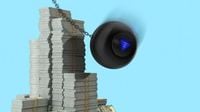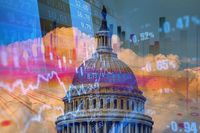As the leaves turn and the days grow shorter in late October 2025, a chill has settled over the American economy—and it’s not just the weather. From Washington’s looming government shutdown to the aisles of thrift stores and the factory floors of box-makers, signals are flashing that the United States may be teetering on the edge of recession. While official declarations from the National Bureau of Economic Research (NBER) remain pending, experts and everyday Americans alike are sensing a slowdown that’s hard to ignore.
Mark Zandi, chief economist at Moody’s Analytics, has sounded the alarm: “Nearly half the states are in a recession already,” he told The Washington Post and MarketWatch. In fact, as of October 24, 2025, Zandi estimates that 22 states are experiencing persistent economic weakness and job losses that are likely to continue. “The overall American economy is on the precipice,” Zandi warned, underscoring the precariousness of the current moment.
On the surface, some government data released before the shutdown painted a picture of relative stability. The gross domestic product (GDP) continues to rise, buoyed in part by the artificial intelligence boom, according to MarketWatch. But beneath that headline number, cracks are spreading. “The job market is weaker,” Zandi noted, and other analysts are quick to point out that official statistics may be lagging behind the reality many Americans face.
Economist Michael J. Hicks of Ball State University drew a stark comparison in The Indianapolis Star: “This moment feels much like late 2007 and early 2008. For a time during that period, the economy felt stable even as we entered recession.” Today, Hicks said, “nearly every other measure of economic activity has stagnated or is in deep decline. The United States may already be in recession. But we don’t feel it yet.”
So, what are the signs that have experts and economists on edge?
Start with the humble cardboard box. According to the American Forest & Paper Association, containerboard production fell about 5% in the second quarter of 2025 compared to the previous year, and several box-making mills have shuttered. As The Washington Post reported, this decline points to a slowdown in goods moving through supply chains—a classic early warning of reduced consumer demand. Pandemic-era e-commerce booms have faded, international shipping is soft, and consumers are tightening their belts as credit costs bite.
On the dinner table, a different indicator is bubbling up. Sales of Hamburger Helper—a staple of cost-conscious home cooks—are up 14.5% year-over-year as of August 2025, according to Eagle Foods. “Hamburger Helper is undoubtedly experiencing a blockbuster resurgence that, in many ways, resembles the runaway success the brand experienced when it first hit store shelves more than a half-century ago,” said Mala Wiedemann, executive vice president of marketing and R&D at Eagle Foods. The trend is driven not just by nostalgia but by necessity, as inflation keeps prices for eggs, beef, veal, sugar, and nonalcoholic beverages rising faster than their 20-year historical averages, per the USDA.
Meanwhile, the roads are seeing fewer new big rigs. Heavy-duty truck sales dropped 14.6% year-over-year in August 2025, ACT Research data shows. Fewer trucks mean fewer goods being shipped—a harbinger of industrial slowdown. The industry faces additional headwinds after President Donald Trump announced a 25% tariff on imported heavy-duty truck models in September 2025, further complicating the market.
Thrift stores and resale platforms are bustling as Americans seek bargains amid economic uncertainty. Visits to thrift shops are up nearly 40% compared with 2019, according to Placer.ai, while online reseller ThredUp reported record quarterly revenue of $77.7 million in Q2 2025, a 16% year-over-year jump. “This visit growth advantage reflects a mix of factors, including heightened economic pressures and sustainability concerns,” Placer.ai noted. The surge in secondhand shopping highlights a broader shift: Americans are prioritizing savings over spending, driven by both necessity and a desire for sustainability.
The job market, once red-hot, has cooled considerably. The rate of Americans quitting their jobs has dropped to its lowest level since 2020, according to the U.S. Bureau of Labor Statistics. A recent Washington Post–Ipsos poll found that 63% of Americans now say it’s a bad time to find a quality job. The Economic Policy Institute’s analysis of the August jobs report revealed that job openings are holding steady, but both hires and quits have edged lower—echoing the stagnant labor market that followed the Great Recession. Economist Allison Shrivastava of Indeed Hiring Lab told The Washington Post, “Job-switching is so fundamentally important to an economy’s health. You really do need churn: That’s the best way for workers to get better wages and to move labor where it needs to go. Right now we’re in a stagnant place where people can’t progress in their careers.”
Housing, too, is sending mixed signals. With mortgage rates hovering around 6%, homeowners are tapping into their existing equity—home equity loan originations jumped 12% early in 2025, according to TransUnion. But new residential building permits were down 11% in August 2025 compared to a year earlier. Zandi observed on social media, “Building permits have been identified as the most critical economic variable for predicting U.S. recessions...inventories of unsold homes are now high and on the rise. In response, builders are pulling back, and permits have started to slump. They are now as low as they’ve been since the pandemic shutdowns.”
Although consumer spending remains healthy on the surface, it’s increasingly concentrated among the wealthy. Moody’s Analytics reports that the top 10% of Americans now account for nearly half of all spending, up from about 35% in the early 1990s. This “K-shaped economy,” as CNBC described, sees affluent Americans maintaining their purchasing power while lower- and middle-class consumers struggle with rising costs for essentials like groceries and gas. Unofficial signals—ranging from increases in missed car payments to more women leaving the workforce—are offering early warnings of deeper trouble ahead, according to Quartz.
Policymakers, meanwhile, are “flying blind,” as Nobel laureate Paul Krugman put it in his newsletter. The government shutdown has cut off access to crucial economic statistics, making it harder for the Federal Reserve to set policy. August 2025 data showed the weakest pace of hiring since 2010, and the Fed is set to announce its latest policies at a meeting on October 29.
Americans’ dissatisfaction is palpable. A poll from the Public Religion Research Institute found that most voters—including nearly 30% of Republicans—gave President Donald Trump low marks on the economy, a signal that public frustration could test the durability of his support as economic anxieties mount.
As the official data catches up with these everyday indicators, Americans are left to navigate an economy that feels increasingly precarious. From shrinking box production to surging thrift store visits, the signs are everywhere—sometimes, it’s the little things that tell the biggest story.


